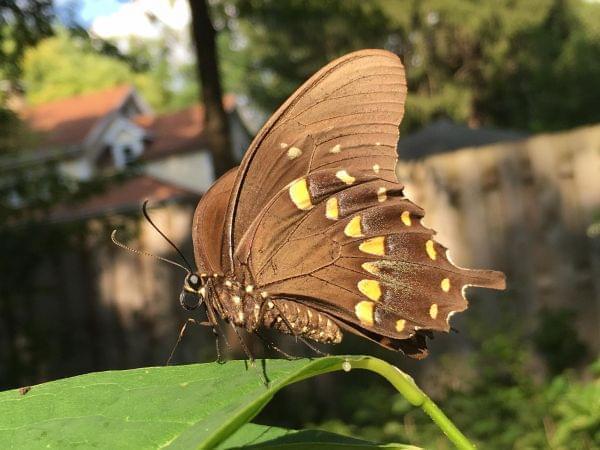Grow Your Own Entertainment with Native Shrubs

Rob Kanter
In a summer with no exotic travel plans, I’m spending a lot of time enjoying my own back yard, especially watching the activity on and around the native shrubs I have planted over the past five years. I’m big into shrubs because much of our yard is shaded by tall trees, and that limits the possibilities for gardening with native plants—neither milkweed nor any of the other sun loving plants of the tallgrass prairie do well there.
A few of my woodland shrubs were given to me by a friend, dug from his property on the Salt Fork River. The majority, however, I’ve bought through an annual sale conducted by the East Central Illinois Master Naturalist program. In all I’ve now planted about 30 native woodland shrubs representing more than a dozen species in our yard.
Rather than boring you with the details of what I love about each one of these plants, let me tell you about one of my favorites, spicebush, which is a common component of the understory in Illinois woodlands and popular among gardeners as well. Spicebush produces showy clusters of little yellow flowers early in spring before it leafs out, and its small fruits (on females only) turn bright red as they mature. Spicebush gets its name from the spicy fragrance given off by twigs and small branches when they’re scraped as with a fingernail.
Spicebush is beautiful in its own right, but I started planting it around my yard with an ulterior motive; I wanted to see for myself the caterpillars of a spicebush swallowtail butterflies. I had seen pictures of them in books and online, but had never been able to find them in the wild.
In the early stages of their development, spicebush swallowtail caterpillars have two ways of avoiding predation. They can stay out of sight by retreating into little shelters, which they create by folding a leaf over on itself into a shape that reminds me of a taco.

Alternatively, when they’re small spicebush swallowtail caterpillars can also hide in plain sight, right on top of a leaf. That’s because their skin is a shiny, mottled gray and black with a saddle of white across the back, which makes them look just like bird poop.
As they mature, spicebush swallowtails maintain the practice of hiding during the day in self-made leaf shelters, but they adopt a new style of camouflage. Their bodies become bright green—and their forward end develops a triangular appearance with dark, eye-like spots, so they end up looking like tiny snakes.
Thanks to my spicebush planting habit, my family and I are now able to watch spicebush swallowtail caterpillars develop every summer.
In addition to the direct entertainment value of hosting showy caterpillars, planting native trees and shrubs in a home landscape can provide a whole range of benefits for people and wildlife alike. If you’re interested to learn more about these I’ve got two suggestions. One is to pick up a copy of the book Bringing Nature Home: How You Can Sustain Wildlife with Native Plants by University of Delaware entomologist Douglas Tallamy.
The other is to check out this year’s sale of native trees and shrubs now being conducted by the East Central Illinois Master Naturalist Program. Thirteen different trees and eleven shrubs are included, with spicebush, of course, among them. Find details about the sale at the website of the East Central Illinois Master Naturalist Program.

